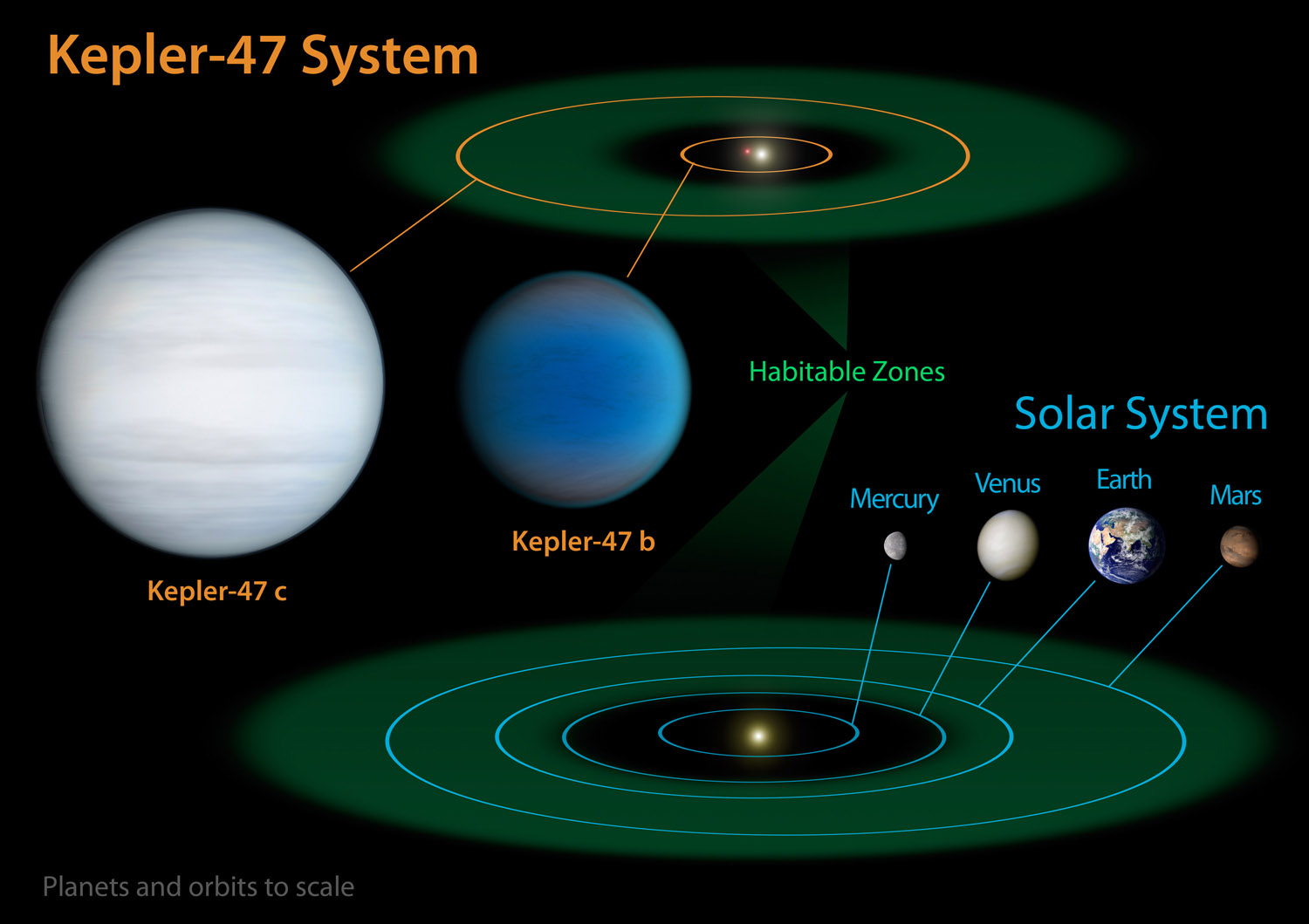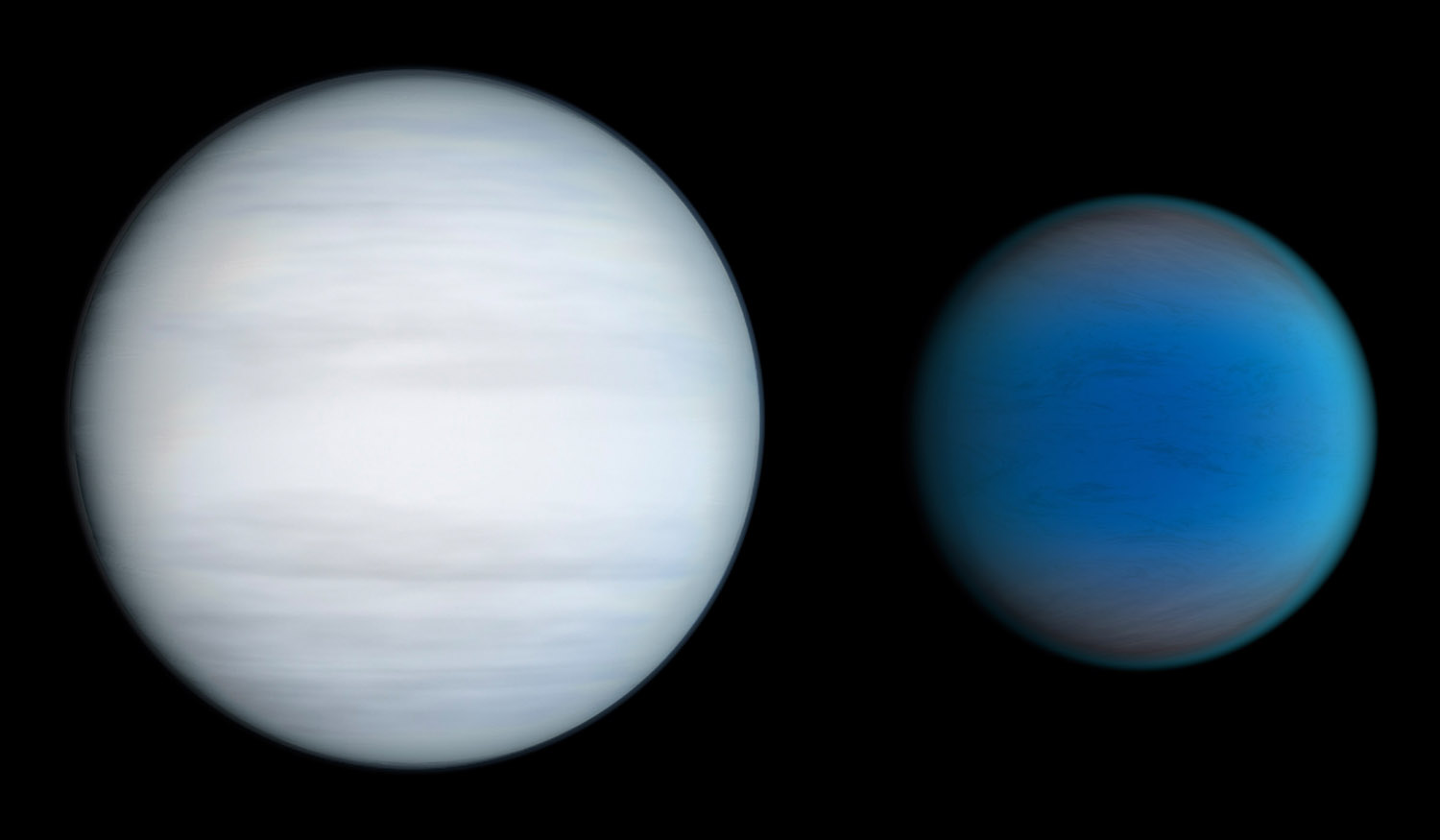Two Alien Planets Found with Twin Suns Like 'Star Wars'' Tatooine

Astronomers have for the first time discovered two alien planets whirling around a pair of stars: a complete solar system with twin suns just like Luke Skywalker's fictional home world Tatooine.
Most stars like our sun are not singletons, but rather come in pairs that orbit each other. Scientists had found planets in these binary systems, so-called circumbinary planets with two suns like Tatooine in the "Star Wars" universe.
To find more circumbinary planets, astronomers analyzed data from NASA's prolific Kepler space telescope, which has detected more than 2,300 potential alien worlds since its March 2009 launch. Kepler had to date detected four systems with circumbinary planets — Kepler-16, 34, 35 and 38.
The scientists have now announced the detection of Kepler-47, the first system seen with multiple worlds encircling a pair of stars. The star and its planets, called Kepler-47b and Kepler-47c, dwell about 5,000 light-years away, in the constellation Cygnus, the Swan. [Planets of the Tatooine-like Solar System (Gallery)]
"Kepler-47 shows us that binary stars can have close-in planetary systems, just like the ones we see in single stars," study lead author Jerome Orosz at San Diego State University told SPACE.com. "Most of the stars in the galaxy are in binary or higher-order multiple systems, so the fact that planetary systems can exist in these types of systems is important. If we were restricted to looking for planets around single stars, we would be missing most of the stars in the galaxy."
Spotting "Tatooine" solar system
The planets are much too far away to see with the naked eye. Rather, they were discovered by the drop in brightness they cause when they cross in front of, or transit, their host stars.
Breaking space news, the latest updates on rocket launches, skywatching events and more!
This dimming is tiny, only 0.08 percent for planet Kepler-47b and 0.2 percent for planet Kepler-47c. By comparison, Venus blocked about 0.1 percent of the sun's surface during its recent transit. Data from Kepler enabled researchers to deduce the relative sizes of the objects and orbits. They also relied on follow-up observations performed by telescopes at the McDonald Observatory in West Texas.
One of the stars is much like our sun, and the other is about a third its size and 175 times fainter. The inner and outer planets are respectively 3 and 4.6 times Earth's diameter — the smaller planet is the smallest circumbinary planet seen yet. [Tatooine-Like System Found, 2 Planets, 2 Stars (Video)]
The inner world completes an orbit every 49.5 days, while the outer one takes 303.2 days, giving it the largest known orbit for any transiting exoplanet. The stars themselves whirl around each other every 7.5 days.
The scientists published their findings online Aug. 28 in the journal Science. They will also detail their results Aug. 29 at the General Assembly of the International Astronomical Union in Beijing.
Planet in the habitable zone?
Intriguingly, the outer planet lurks in the system's habitable zone, where a rocky planet like Earth is the right temperature to have liquid water on its surface.
"We've learned that circumbinary planets can be like the planets in our own solar system, but with two suns," said study co-author Joshua Carter at the Harvard-Smithsonian Center for Astrophysics.
Although the outer planet is probably a gas giant slightly larger than Uranus and therefore not suitable for life as we know it, these findings do show that circumbinary planets can and do exist in habitable zones.
"The thing I find most exciting is the potential for habitability in a circumbinary system," said study co-author William Welsh at San Diego State University. "Kepler-47c is not likely to harbor life, but if it had large moons, those would be very interesting worlds."
Weird weather on Tatooine planets
Circumbinary planets might undergo relatively wild climate swings.
On Earth, the sun is a relatively stable source of light, with the solar insolation or energy we receive only varying by 0.1 percent or so. "As a result, we don't need to worry about what the sun is doing, at least over time-scales of years to decades," Orosz said. "For a planet around a binary system, there can be changes in the insolation of several percent on the time-scale of days to weeks. In addition, if the planet's rotation axis is tilted, then that also has an effect. Therefore the seasons are rapid and complicated."
"Also, let's say for the sake of discussion that the planet's rotation period is 24 hours, just like the Earth," he added. "Because you have two suns instead of one, you can have more than 12 hours of daylight, depending on the positions of the stars at sunrise or sunset."
In addition, since all the circumbinary planets the Kepler space telescope has discovered have orbits closely aligned with the orbits their stars have with each other, "you would see your suns eclipse each other on a regular basis," Orosz said. "In the case of Kepler-47, when the secondary star passes in front of the primary, the total light drops by 15 percent. This would happen every 7.5 days or so."
More exotic alien solar systems possible
The new discovery show that planetary systems can form and survive even in the chaotic environment around binary stars.
The researchers expect that the planets in Kepler-47 originated much farther out than their present orbits, at locations where the conditions for the formation of giant planets are more favorable. They eventually then migrated inward due to interactions with the disk of gas and dust that also encircled the stars.
"We think these planets and most other planets formed from a residual disk of debris left over from the star-formation process," Orosz said. "It was not at all obvious that this disk could survive near a newly formed binary star, given the orbital motions of the two stars. However, it now appears that apart from minor differences in the orbital spacings, planetary systems around binary stars can be similar to those around single stars."
In the future, the researchers want to look for smaller and smaller alien planets around binary stars.
"We are at the limit of what simple visual searches can do, so we need better software to help us automate the process," Orosz said. "Given more time and data, I think we can find more circumbinary planetary systems in the Kepler data."
Follow SPACE.com on Twitter @Spacedotcom. We're also on Facebook & Google+.
Join our Space Forums to keep talking space on the latest missions, night sky and more! And if you have a news tip, correction or comment, let us know at: community@space.com.

Charles Q. Choi is a contributing writer for Space.com and Live Science. He covers all things human origins and astronomy as well as physics, animals and general science topics. Charles has a Master of Arts degree from the University of Missouri-Columbia, School of Journalism and a Bachelor of Arts degree from the University of South Florida. Charles has visited every continent on Earth, drinking rancid yak butter tea in Lhasa, snorkeling with sea lions in the Galapagos and even climbing an iceberg in Antarctica. Visit him at http://www.sciwriter.us


